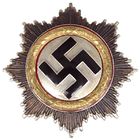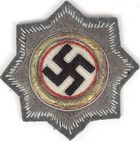German Cross
| German Cross Deutsches Kreuz |
|
|---|---|
  German Cross in Gold (left) and Silver (right) |
|
| Awarded by Nazi Germany | |
| Type | Badge |
| Eligibility | Military personnel |
| Campaign | World War II |
| Status | Obsolete |
| Statistics | |
| Established | 28 September 1941 |
| Total awarded | ~26,000 in Gold ~ 2,500 in Silver |
 German Cross in Silver and Gold |
|
The German Cross (German: Deutsches Kreuz) was instituted by Adolf Hitler on 16 November 1941 as an award ranking higher than the Iron Cross First Class but below the Knight's Cross of the Iron Cross.
The German Cross was issued in two degrees: gold and silver (the color of the laurel wreath around the swastika), the former being an award for bravery, the latter being for distinguished service and was considered a continuation of the War Merit Cross with swords. The German Cross was unique in that the Gold and Silver degrees were considered as separate awards but should not be worn simultaneously. However, pictures of recipients wearing both grades exist. (see Odilo Globocnik). There are a total of 11 recorded instances of a recipient receiving both the German Cross in Silver and Gold during the war.
A special grade, the German Cross in Gold with Diamonds, was manufactured towards the end of World War II but was never bestowed.
This award was actually more a star than a cross (although one of the German names for the swastika was Hakenkreuz, "hooked cross"), and had a rather gaudy design, helping it gain its nicknames as "Hitler's Fried Egg", "patriotic rear reflector" and "Party emblem for the nearsighted". It had a diameter of 6.5 cm and was worn on the righthand pocket of the tunic. If a recipient was awarded both the silver and gold divisions, both of them could be worn on the uniform.

This award was also available in cloth form, which made for easier wear on the combat uniform; Helmuth Weidling wore this variety during his defense of Berlin in April-May 1945. Far more awards in gold (combat) were made than in silver (support).
The cross title refers to the fact that the swastika is a cross, a sun-cross.
In 1957 an alternative version for replacement of the German Cross came out-it features a Iron Cross in place of the swastika
References
For Führer And Fatherland: Military Awards of the Third Reich by LTC John R. Angolia. 1976 R. James Bender Publishing. ISBN 0-912138-14-9
"The German Cross in Gold and Silver" by Dietrich Maerz, B&D Publishing LLC, Richmond, MI, 2009, ISBN 978-0-9797969-2-0